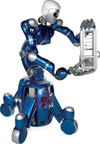

The development of humanoid robots has made significant progress in recent years. Rollin’ Justin, developed by the German Aerospace Center (DLR), can perform complex, two-handed manipulations and can move freely about rooms due to a mobile platform. Rollin’ Justin is a prototype of the kind of service robot that could be used in future households for everyday tasks or for fetching and bringing items in a warehouse. The fast communication necessary for the movement sequences takes place via EtherCAT, while the Beckhoff TwinCAT PLC automation software takes care of control.
Rollin’ Justin is the result of over 10 years of research at the German Aerospace Center (DLR) in Wesling. The lightweight robot arms and hands developed by the DLR like those used, for example, for maintenance work in space are the basis for the development of a mobile robot in the shape of a human being. The robot’s grasping range can be extended by means of the torso and the mobile platform with four separately retractable and extendable legs mounted on roller bearings, analogous to the trunk and leg movements with which a human extends his radius of action. The upper body alone has 43° of freedom equipped with torque sensors; a total of 51 joints make Rollin’ Justin a highly mobile automaton that can manipulate and interact sensitively. The robot skilfully manipulates objects with two hands and is able, for example, to carry a crate or prepare tea. The latter requires complex coordination of movements. The robot must grasp the tea caddy with one hand, in order to unscrew it with the other hand. Then it fills instant tea granulates into a drinking glass, whereby it meters the quantity exactly by tapping the plastic container lightly with a finger. Finally, it pours water into the glass from a decanter.
Torque sensors permit sensitive manipulations
A looser or tighter coordination of arms and hands is required, depending upon the kind of manipulation: for instance the grasping of large objects, such as a crate, requires the tight coordination of both arms. The opening of a screw cap, on the other hand, requires the synchronous movement of hand and arm. However, Rollin’ Justin also interacts with humans and its environment: if it knocks against something or touches an object or a person, it notices that and aborts the movement, or it asks whether it should continue working. Via an integrated speech recognition system, the robot knows approximately 100 words and can combine them into meaningful phrases. Apart from that, it uses built-in cameras to collect information from its environment and can identify objects in order to be able to orientate itself accordingly. The equipment with torque sensors, eg, in the fingers, ensures that Rollin’ Justin can also grasp sensitive objects, such as strawberries, without crushing them. The robot’s footprint is variable: when performing highly dynamic actions or actions requiring a particularly long reach, it stabilises its upper body by enlarging its footprint; to do this it extends its legs. If it needs to traverse a narrow passage, it retracts the legs again.
EtherCAT – the ideal communication platform
“The utilisation of proven hardware components from third-party suppliers allowed us to save time-consuming development work when building Rollin’ Justin,” explains Klaus Kunze from the Institute of Robotics and Mechatronics, DLR. “Our selection was primarily determined by the desired functions and the necessity of a compact design.”
However, this presented the DLR with the challenge of having to integrate the most diverse real-time protocols. The components used communicate via CAN, CANopen, SERCOS, SpaceWire and EtherCAT. These different fieldbuses are mapped via the Beckhoff TwinCAT PLC automation software on an EtherCAT slave. All data necessary for control are available synchronously via a single real-time capable bus protocol in a Matlab/Simulink environment on the separate computer that controls the entire platform, including the upper body. “We needed a solution that, on the one hand, would support the communication technology of the components, while on the other not limiting their performance capability, such as the 1 ms cycle time of the SERCOS drives and the short dead times. We have found the ideal communication system in EtherCAT,” says Kunze. The force sensors and the servo drives are connected via standard EtherCAT Terminals from Beckhoff. Beckhoff SSI terminals acquire the data from the position sensors of the robot legs. The SERCOS drives of the arms and the torso are connected via Beckhoff SERCOS master PCI plug-in cards. Rollin’ Justin represents an optimal experimentation platform for the DLR to test robust control strategies and intelligent action planning for the realisation of complex, two-handed manipulation tasks.
| Tel: | +27 11 795 2898 |
| Email: | [email protected] |
| www: | www.beckhoff.com |
| Articles: | More information and articles about Beckhoff Automation |

© Technews Publishing (Pty) Ltd | All Rights Reserved